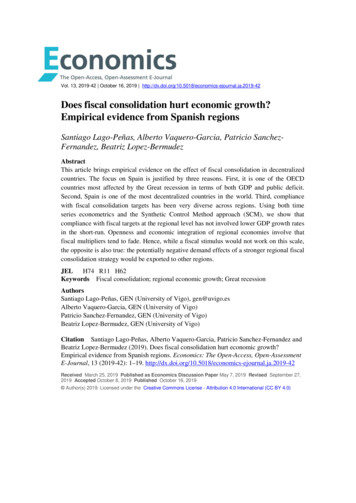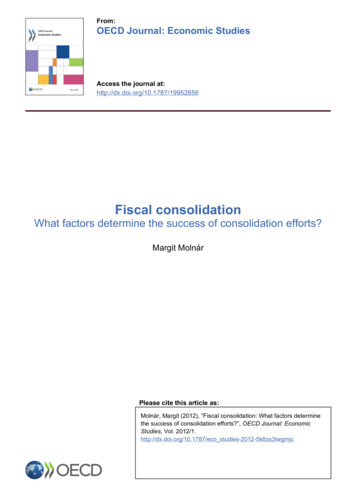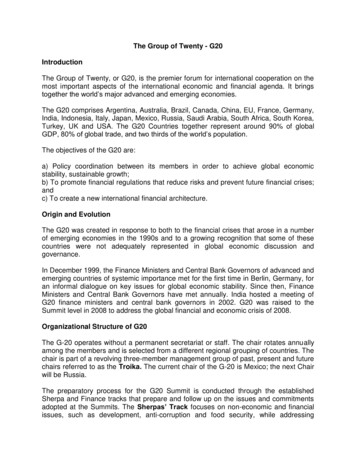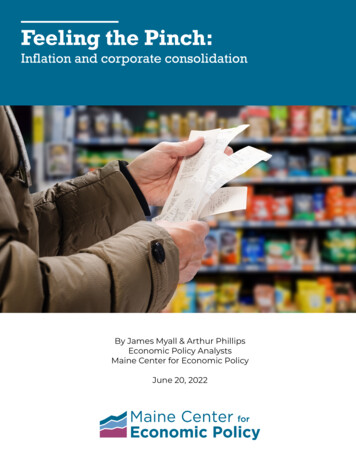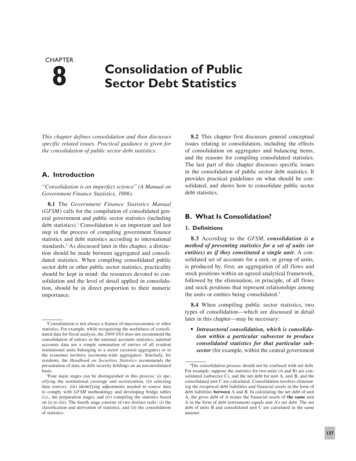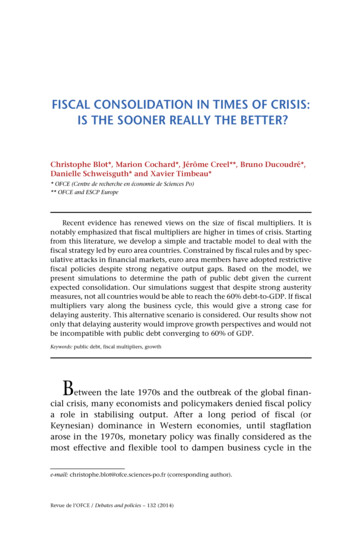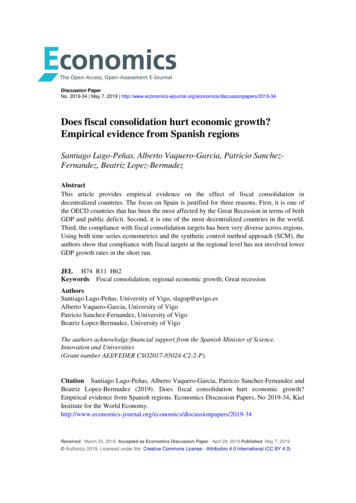
Transcription
Discussion PaperNo. 2019-34 May 7, 2019 sionpapers/2019-34Does fiscal consolidation hurt economic growth?Empirical evidence from Spanish regionsSantiago Lago-Peñas, Alberto Vaquero-Garcia, Patricio SanchezFernandez, Beatriz Lopez-BermudezAbstractThis article provides empirical evidence on the effect of fiscal consolidation indecentralized countries. The focus on Spain is justified for three reasons. First, it is one ofthe OECD countries that has been the most affected by the Great Recession in terms of bothGDP and public deficit. Second, it is one of the most decentralized countries in the world.Third, the compliance with fiscal consolidation targets has been very diverse across regions.Using both time series econometrics and the synthetic control method approach (SCM), theauthors show that compliance with fiscal targets at the regional level has not involved lowerGDP growth rates in the short run.JEL H74 R11 H62Keywords Fiscal consolidation; regional economic growth; Great recessionAuthorsSantiago Lago-Peñas, University of Vigo, slagop@uvigo.esAlberto Vaquero-Garcia, University of VigoPatricio Sanchez-Fernandez, University of VigoBeatriz Lopez-Bermudez, University of VigoThe authors acknowledge financial support from the Spanish Minister of Science,Innovation and Universities(Grant number AEI/FEDER CSO2017-85024-C2-2-P).Citation Santiago Lago-Peñas, Alberto Vaquero-Garcia, Patricio Sanchez-Fernandez andBeatriz Lopez-Bermudez (2019). Does fiscal consolidation hurt economic growth?Empirical evidence from Spanish regions. Economics Discussion Papers, No 2019-34, KielInstitute for the World /discussionpapers/2019-34Received March 25, 2019 Accepted as Economics Discussion Paper April 24, 2019 Published May 7, 2019 Author(s) 2019. Licensed under the Creative Commons License - Attribution 4.0 International (CC BY 4.0)
I. MOTIVATIONThe Great Recession revived the long-standing debate between Keynesians and“supply-side” scholars (Andrés and Doménech, 2013), and it reopened the discussion onthe relevance of fiscal multipliers and the effect of fiscal consolidation on GDP growthin the short run. Researchers are still divided between those who affirm that fiscalconsolidation can end up producing expansive effects (Giavazzi and Pagano, 1990;Alesina and Ardagna, 1998 and 2010), especially when based on expenditure cuts(Alesina et al., 2019), and those who maintain that immediate fiscal austerity iscounterproductive for economies (Blanchard and Cottarelli, 2010; Blanchard and Leigh,2013; De Grauwe and Ji, 2013).A middle position outlines the importance of the initial conditions (economic andfiscal), claiming that the anticipated consolidation is better than a progressive form if thestarting value of the debt/GDP ratio is huge (Nickel and Tudyka, 2013) or if the period ofconsolidation effort follows a financial crisis (Buti and Pench, 2012). Moreover, thecyclical situation of the economy is relevant: fiscal multipliers are significantly higher inturbulent times (Auerbach and Gorodnichenko, 2012; De Mello, 2013; Warmedinger etal., 2015; Hernández de Cos and Moral-Benito, 2016).As a consequence of this diversity, opposite estimates of fiscal multipliers arereported. Spilimbergo et al. (2009) show fiscal multipliers ranging between -1.5 and 5.2,with Corsetti et al. (2012) reducing these magnitudes to -0.7 and 2.3, and Gechert andWil (2012) to -1.3 and 2.8.The divergence shows the difficulty of isolating the effects of fiscal stimuluspolicies from those of other factors affecting the economy: the exchange rate, monetarypolicy, health of public finances, availability of bank lending and so on. In order to controlby those factors, the analysis of highly decentralized countries can provide furtherinsights into this empirical question. Comparing the performance of regions that aresubject to the same macroeconomic conditions but committed to fiscal consolidation todifferent degrees makes the analysis much easier than comparing countries.Insofar as this analysis requires strong expenditure decentralization, a regionalcapacity to enter into debt and a substantial shock affecting public finances and involvingthe need for fiscal consolidation, Spain seems to be the best candidate among the OECDmembers. In short, our analysis is based on the short-run GDP dynamics of the regional
leader in the compliance with fiscal consolidation targets (Galicia) and compares theobserved GDP growth rates with what would have happened with softer regional fiscalconsolidation. Two complementary analyses are carried out. In section 3, we perform atime-series analysis and compare the observed GDP growth rates with a forecast. Insection 4, we rely on the more sophisticated synthetic control method (SCM) approach tomake the comparison. Section 5 concludes.II. THE FISCAL ADJUSMENT IN SPAIN AND THE CASE OF GALICIASpain is one of the most decentralized countries in the world (Lago-Peñas et al.,2017). In terms of the share of sub-national (both local and regional) expenditure of thetotal, it ranks fifth in the OECD. 1 If the attention is focused on the regional tier, Spaintops the ranking for the European Union (EU), with figures similar to those of Canadaand Switzerland. Moreover, the impact of the Great Recession on the deficit and debt inSpain has been huge. Public debt rose from 36% of the GDP in 2007 to 100% (LagoPeñas, 2017).While the economic crisis struck the GDP growth rates of all regions (Figure 1)and the deficit expanded in all cases, there are significant differences in theimplementation of budget consolidation and thus the meeting of the fiscal targets agreedwith the European Commission.[Insert Figure 1 near here]Figures 2 and 3 show the evolution of the regional average deficit and debt overthe period 2008 to 2017. The regional deficit increased substantially to exceed -3% of theGDP in 2010 and 2011. Correspondingly, public indebtedness rose from less than 7% ofthe GDP in 2008 to almost 25% in 2017. The figures for Galicia are significantly lowerfor both deficit and debt.[Insert Figure 2 near here]Moreover, according to the Regional Authority Index, computed by Hooghe et al. authority/), Spain was second in the last year available (2010).Only Germany shows a higher score. The sample consists of all the EU member states, all the memberstates of the OECD, all the Latin American countries, ten countries in Europe beyond the EU and elevencountries in the Pacific and South-East Asia.11
[Insert Figure 3 near here]Lago-Peñas and Vaquero (2016) and Lago-Peñas et al. (2017) demonstrate thatthe evolution of deficits and fiscal consolidation efforts differed significantly acrossregions. Table 1 summarizes the non-compliance over the period 2009–2016 regardingthe deficit target, the spending rule and the debt target. In spite of a drop in the totalrevenues over the average, 2 Galicia stands out as the region with the highest degree offulfilment. 3Finally, the available evidence shows that spending cuts account for the lion’sshare of fiscal consolidation in all the regions (MINAHP, 2012; Cantalapiedra and López,2013). Taking into account increases in both tax rates and tax benefits, the net averageeffect is neutral (AIReF, 2016), with some regions in negative figures (especially Madridand Cantabria, due to tax cuts in wealth taxes). For the case of Galicia, the net effect ispositive but small. In 2016, the contribution of net tax increases to fiscal stability wasequivalent to 0.2% of the regional GDP.[Insert Table 1 near here]When looking for the reasons explaining this better fiscal performance of Galicia,two related factors clearly emerge: the electoral cycle and political will. Regarding thefirst factor, four Spanish regions enjoy an asymmetrical electoral cycle: Galicia, PaísVasco, Cataluña and Andalucía. The acknowledgement by the Spanish centralgovernment of the effect of the international economic crisis occurred in summer 2008.In March 2009, elections were held in Galicia and País Vasco. The following electionswere in Cataluña in November 2010 and in the remaining regions in May 2011 (andMarch 2012 in Andalucía). Concerning the second factor, the new conservative Galicianincumbent replaced a leftist coalition and made fiscal austerity the main political messageof its political campaign. Hence, the new government took advantage of the timing of theelection to adapt the regional budget to the new economic scenario. Regional expenditureThe regions where both the total revenues and the total expenditure dropped more than the regionalaverage are Galicia, Baleares, Castilla y León, Extremadura, Navarra and Andalucía.3Lago-Peñas and Vaquero (2016) identify several clusters according to the dynamics of deficit. Themembers of the leader group are Galicia, Madrid and Canarias. In contrast, the regions in the cluster withthe worst results are Murcia, Comunidad Valenciana, Cataluña and Baleares.22
cuts started in 2009 and intensified in 2010. Since then, austerity has been the cornerstoneof political will of the regional president and ministers, including more exigent measuresthan in most regions, like the cut in civil servants’ wages approved in 2013 and extendeduntil 2017. Surprisingly, and in sharp contrast to the electoral results in other regions andcountries, the political support for the Galician incumbent increased in the 2012 and 2016elections.To analyse the effect on growth of the stronger fiscal consolidation process carriedout in Galicia, two complementary methodologies are used: a standard econometricapproach based on a dynamic time-series model (section 3) and the synthetic controlmethod originally proposed by Abadie and Gardeazabal (2003) in section 4. In both cases,we compare two series: the observed GDP growth rate affected by cross-regionalasymmetries in the intensity of fiscal consolidation since 2009 and the simulated GDPgrowth rate from extrapolating the structural relationship before 2009.III. EMPIRICAL ANALYSIS I: A STANDARD ECONOMETRIC APPROACHThe departure point of the first econometric analysis is the following AR (2)model:𝐺𝐺𝐺𝐺𝐺𝐺𝑡𝑡 𝛽𝛽0 𝛽𝛽1 𝑆𝑆𝑆𝑆𝑆𝑆𝑆𝑆𝑆𝑆𝑡𝑡 𝛽𝛽2 𝐺𝐺𝐺𝐺𝐺𝐺𝑡𝑡 1 𝛽𝛽3 𝐺𝐺𝐺𝐺𝐺𝐺𝑡𝑡 2 𝜀𝜀𝑡𝑡(1)In Equation (1), the variables GAL and SPAIN are the gross domestic product (GDP) andthe interannual real growth rate of Galicia and Spain, respectively. The data for the formerare from the Galician Institute of Statistics (www.ige.eu), and the data for Spain are fromthe National Institute of Statistics (www.ine.es). In both cases, we rely on the quarterlyseasonally adjusted data provided on the websites. We use Eviews 10.5 for theeconometric estimates.The estimation period is 1996:Q1 to 2008:Q4. The selection of the starting pointis based on the evidence provided by Lago-Peñas (2001), who shows that the synchronyof the Spanish and Galician business cycles has substantially converged since the early1990s. Therefore, the goodness of fit will tend to be significantly higher, while the samplesize is large enough to perform estimates. Two lags for the variable GAL are enough to3
capture the dynamics. 4 To rule out specification problems, we perform twocomplementary tests on the specification. First, a Hausman test on the endogeneity of thevariable SPAIN’s p-value of the corresponding Wald test is high (p-value 0.25) and thusthe null hypothesis of exogeneity is not rejected. 5 Second, a Granger causality test isperformed to verify the causation order. The results in Table 2 clearly show that we canreject the null hypothesis of no causation from SPAIN to GAL (p-value 0.001) but notthe opposite causation (p-value 0.88).[Insert Table 2 near here]Table 3 reports the ordinary least squares (OLS) estimate of Equation (1). The fitis good (R2 0.853). The null hypothesis of no autocorrelation cannot be discardedaccording to the Breusch–Godfrey serial test (p-value 0.12). The correspondingcorrelogram yields the same conclusion. Both SPAIN and the first lag of GAL, but not thesecond one, are highly significant variables, with coefficients around 0.6.[Insert Table 3 near here]Our econometric results allow us to forecast the Galician GDP growth rate from2009 to 2017. In particular, using observed data for the variable SPAIN, we perform adynamic forecast assuming that the relationship estimated in Table 2 will hold. Figure 4shows both series. The observed GDP growth is clearly above the forecasted growththroughout the period 2009–2014. The sign of the differential changes at the end of 2014,when the forecasted growth exceeds the observed growth. Hence, in 2015 and 2016, theGalician GDP growth rate was slower that it should be, taking into account the recoveryof the Spanish economy. The situation changes again at the end of 2016 when the twoseries overlap. Moreover, in 2017, the observed GDP growth rate is slightly higher thanthat forecasted.Adding the first lag of SPAIN and the third one of GAL on the right-hand side does not improve the fitness,reducing the adjusted R2. According to a joint Wald test, their coefficients are not significantly differentfrom zero (p-value 0.17).5The test is implemented in two steps. First, SPAIN is regressed on its own first two lagged values and thetwo lagged values of GAL. The residuals obtained are included in the original equation. The null hypothesisis that they are not statistically significant.44
[Insert Figure 4 near here]In sum, looking at the whole period, the observed GDP growth rate is significantlyabove the forecasted rate. Hence, the data do not support the existence of a price to payfor fiscal consolidation in terms of short-run GDP growth. 6IV. EMPIRICAL ANALYSIS II: THE SYNTHETIC CONTROL METHODAPPROACHThe synthetic control method (SCM) is based on the seminal contribution byAbadie and Gardeazabal (2003), who analyse the effects of terrorism in the BasqueCountry. The SCM is refined in subsequent works by Abadie et al. (2010) on the effectsof the anti-tobacco law in California and Abadie et al. (2015) on the costs of reunificationin Germany.The SCM analyses the consequences of a specific event or intervention in a regionby comparing the observed data with what would have happened in the absence of theintervention. Insofar as it requires the creation of a counterfactual, the first step of themethod is to find other similar regions that remained unaffected by the event (thecomparison units) and merge them to create a synthetic region close to the case of interest.More formally, the SCM supposes that there are J 1 regions or “units”, where j 1 is the“treated unit” and units j 2 to j J 1 constitute the “donor pool” (Abadie et al., 2010:493–505). Following Abadie et al. (2010) and Abadie et al. (2015), we assume that thesample is a balanced panel and includes a positive number of pre-intervention periods,T0, as well as a positive number of post-intervention periods, T1, with T T1 T0.The synthetic control is defined as a weighted average of the units in the donorpool represented by a (J 1) vector of weights W (w2, .,wJ 1), with 0 wj 1 for j 2, .Jand w2 . wJ 1 1. Choosing a particular value for W is equivalent to choosing asynthetic control. Let X1 be a (k 1) vector containing the values of the pre-interventioncharacteristics of the treated unit that we aim to match as closely as possible, and let X0This conclusion holds if we discount the most relevant positive asymmetric shock affecting the Galicianeconomy during the period, the Jacobean year 2010. According to BBVA research (2010), the GalicianGDP growth rate would have been 0.5–0.6% higher in 2010, 0.2% higher in 2011 and 0.1% higher in2012 thanks to the impact of the Jacobean year on tourism.65
be the k J matrix collecting the values of the same variables for the units in the donorpool. The pre-intervention characteristics in X1 and X0 may include the pre-interventionvalues of the outcome variable.The difference between the pre-intervention characteristics of the treated unit anda synthetic control is given by the vector X1-X0W. As in the research by Abadie et al.(2010) and Abadie et al. (2015), we select the synthetic control, W*, that minimizes thesize of this difference. This can be operationalized in the following manner. For m 1, .,k, let X1m be the value of the m-th variable for the treated unit and let X0m be a 1 J vectorcontaining the values of the m-th variable for the units in the donor pool. Abadie et al.(2015) choose W* as the value of W that minimizes: 𝑘𝑘𝑚𝑚 1 𝑣𝑣𝑚𝑚 (𝑋𝑋1𝑚𝑚 𝑋𝑋0𝑚𝑚 𝑊𝑊)2(2)where vm is a weight that reflects the relative importance assigned to the m-th variableswhen we measure the discrepancy between X1 and X0W. Of course, it is crucial that thesynthetic control closely reproduces the values that the variables with large predictivepower over the outcome of interest take for the treated unit. Accordingly, those variablesshould be assigned large vm weights. In the empirical application below, we apply a crossvalidation method to choose vm.Let Yjt be the outcome of unit j at time t. In addition, let Y1 be a (T1 1) vectorcollecting the post-intervention values of the outcome for the treated unit. That is, Y1 (Y1To 1, ., Y1T)’. Similarly, let Y0 be a (T1 J) matrix, where column j contains the postintervention values of the outcome for unit j 1. The synthetic control estimator of theeffect of the treatment is given by the comparison of post-intervention outcomes betweenthe treated unit, which is exposed to the intervention, and the synthetic control, which isnot exposed to the intervention, Y1-Y0W*. That is, for a post-intervention period t (witht T0), the synthetic control estimation of the effect of the treatment is given by thecomparison between the outcome for the treated unit and the outcome for the syntheticcontrol in that period:𝐽𝐽 1𝑌𝑌1𝑡𝑡 𝑤𝑤𝑗𝑗 𝑌𝑌𝑗𝑗𝑗𝑗𝑗𝑗 26
The matching variables in X0 and X1 are meant to be predictors of post-interventionoutcomes. These predictors are themselves not affected by the intervention. To choosethe weights vm in Equation (2), a cross-validation technique is used, following Abadie etal. (2015); these weights minimize the root mean square prediction error:𝑅𝑅𝑅𝑅𝑅𝑅𝑅𝑅𝑅𝑅 𝑇𝑇0𝐽𝐽 1𝑡𝑡 1𝑗𝑗 221/21 𝑌𝑌1𝑡𝑡 𝑤𝑤𝑗𝑗 𝑌𝑌𝑗𝑗𝑗𝑗 𝑇𝑇0In our case, the variables used for the SCM are reported in Table 4. We includevariables on demography, the labour market, human capital, physical capital (both publicinfrastructure and private), exports and foreign investment inflows, poverty,competitiveness and the sectorial structure. While in most cases we use average valuesover the pre-treatment period, data for the year 2008 are used for some variables. Thesample covers the period 1995–2016 for the 17 Spanish regions. We choose the weightsvm to minimize the root mean square prediction error over the validation period. Table 5shows the computed weights, which are those used to create the “synthetic Galicia”, forwhich the values are collected together with the corresponding actual values in Table 6.[Insert Table 4 near here][Insert Table 5 near here][Insert Table 6 near here]Figure 5 shows both the observed and the synthetic growth rates of Galicia for theperiod 2009 to 2016. Except for the years 2009 and 2011, the negative observed valuesare lower than those in the counterfactual, and, in the years of growth, the real value ishigher than the synthetic one.[Insert Figure 5 near here]Figure 6 presents the previous annual growth rates. In both cases, the value isnegative, but the actual rate (-2.30%) is clearly lower in absolute terms than thatcorresponding to the synthetic unit (-3.91%).7
[Insert Figure 6 near here]Figure 7 shows both the actual and the synthetic values of the variation rates ofthe GDP for Galicia from 1995 to 2016. While most of the actual values are lower before2008, since then they have been higher than the synthetic estimate of the region’s growth.This again supports the idea that fiscal austerity implemented to meet the deficit targetshas not involved an evident price in terms of regional economic growth.[Insert Figure 7 near here]To check the robustness of the results, we replicate the analysis, constraining thedonor regions to those in which the deviation from the fiscal consolidation targets hasbeen wider (Castilla-La Mancha, Cataluña, Comunidad Valenciana and Murcia). Theregional weights that minimize the root mean square prediction error (RMSPE 0.0071)over the validation period are 0.791 for Cataluña and 0.219 for Castilla-La Mancha.Figure 8 shows the new results. Over the period 2004–2012, the growth of thecounterfactual of Galicia is below the actual growth. After 2013, the values are slightlyhigher, but the positive gap in the counterfactual in recent years does not compensate forthe negative gap in 2012.[Insert Figure 8 near here]V. CONCLUSIONSRegional governments provide a convenient field to test whether fiscalconsolidation involves a price to pay in terms of the short-run GDP growth rate. Giventhe high fiscal decentralization in Spain, the depth of the effects of the Great Depressionon the public accounts at the regional level in Spain and the diversity of commitments tofiscal targets, this country is the best case study among the OECD members.To perform the test, we focused our attention on the region showing a betterperformance in terms of compliance with the fiscal targets agreed with the EuropeanCommission. In particular, we compare the observed short-run GDP growth rates with8
two simulations. The first one is based on the estimate of a time-series model relating theGDP dynamics of Galicia and Spain over the period 1995–2008. The second one relieson the more sophisticated synthetic control method (SCM) approach. In both cases, weshow that stricter fiscal consolidation has not produced a significant reduction ineconomic growth. Indeed, the economic performance of Galicia would have been slightlybetter than expected using both methodologies.Our interpretation of the results is closely related to the traditional theory of fiscalfederalism (Musgrave, 1959). According to it, openness and economic integration ofregional economies involve fiscal multipliers that tend to fade. A fiscal stimulus wouldnot work on this scale. Our results show that the opposite is also true: the potentiallynegative demand effects of a stronger regional fiscal consolidation strategy would beexported to other regions.The most relevant policy implication of our results is that decentralization couldindeed contribute to the compliance with fiscal consolidation plans on the national scale,reversing the usual arguments on both the common pool’s problem affecting fiscalstability in decentralized countries and the challenge involved by “soft budgetconstraints” and bailout expectations (Goodspeed, 2017). If the negative demand effectsof regional fiscal consolidation are mostly exported to other regions, one of the reasonsmost often argued to delay deficit cuts and compliance with fiscal targets is deactivated.9
REFERENCESAbadie, A. and Gardezabal, J. (2003). The economic costs of conflict: A case study of theBasque Country. American Economic Review, 93(1), 113-132.https://www.aeaweb.org/articles?id 10.1257/000282803321455188Abadie, A. Diamond, A and Hainmueller, J. (2015). Comparative Politics and theSynthetic Control Method. American Journal of Political Science, 59(2), 495-510.https://doi.org/10.1111/ajps.12116Abadie, A., Diamond, A. and Hainmueller, J. (2010). Synthetic control methods forcomparative case studies: Estimating the effect of California’s tobacco controlprogram. Journal of the American Statistical Association, 105(490), IReF (2016). Informe sobre el establecimiento de los objetivos individuales deestabilidad presupuestaria y deuda pública para las Comunidades ividuales-de-las-comunidades-autonomas/AIReF (2018). Autoridad Independiente de Responsabilidad Fiscal (www.airef.es).Alesina, A., and Ardagna, S. (1998). Tales of fiscal adjustment. Economic Policy, 13(27),488-545. https://doi.org/10.1111/1468-0327.00039Alesina, A., and Ardagna, S. (2010). Large changes in fiscal policy: taxes versusspending. Tax Policy and the Economy, 24(1), 35-68.http://doi.org/10.3386/w15438Alesina, A., Favero, C., and Giavazzi, F. (2019). Austerity. When it works and when itDoesn’t. Princeton University Press, Princeton.Andrés, J., and Doménech, R. (2013). Fiscal adjustment and economic growth in Europe.BBVA Economic Watch Europe, /130219 Europe WatchFiscal adjustment tcm348-374754.pdfAuerbach, A.J., and Gorodnichenko, Y. (2012). Measuring the output responses to fiscalpolicy. American Economic Journal: Economic Policy, 4(2), 1-27.http://doi.org/10.1257/pol.4.2.1BBVA Research (2010). Impacto del año Xacobeo en la economía /1003 observatorioregionalespana tcm348-217035.pdf10
BEDE (2018). Boletín Estadístico del Banco de st/bolest.htmlBlanchard, O.J., and Leigh, D. (2013). Growth forecast errors and fiscal multipliers.American Economic Review, 103(3), ard, O., and Cottarelli, C. (2010). Ten commandments for fiscal adjustment inadvanced economies. VoxEU. org, al-adjustment-advancedeconomiesButi, M., and Pench, L.R. (2012). Fiscal austerity and policy credibility. In Corsetti, G.(eds.) Austerity: Too Much of a Good Thing? 2012, nd-policy-credibilityCantalapiedra, C., and Lopez, C. (2013). Las líneas presupuestarias de las comunidadesautónomas y el ajuste estructural del gasto. Cuadernos de InformaciónEconómica, 231, ?codigo 4122955Corsetti, G., Meier, A., and Müller, G. (2012). What Determines Government SpendingMultipliers? Economic Policy, 27(72), 0295.xDataComEx (2018). Estadística de comercio exterior extranjerohttp://datacomex.comercio.es/principal comex es.aspxDataInvEx (2018). Estadísticas de inversión extranjera en Españahttp://datainvex.comercio.es/principal invex.aspxDe Grauwe, P., and Ji, Y. (2013). From Panic‐Driven Austerity to SymmetricMacroeconomic Policies in the Eurozone. JCMS: Journal of Common MarketStudies, 51(S1), 31-41.https://doi.org/10.1111/jcms.12042De Mello, L., 2013, “What Can Fiscal Policy Do in the Current Recession? A Review ofRecent Literature and Policy Options,” Review of Public Economics scarga.cshtml?ruta /docs/destacados/publicaciones/revistas/hpe/204 Art5.pdfEC (2018). Base de datos de European Comissionhttp://ec.europa.eu/regional thods-andfindings11
FEDEA (2018). Documentos de Economía Regional y egional-y-urbana/Gechert, S., and Will, H. (2012). Fiscal multipliers: A meta regression análisis. WorkingPaper 2012/97, Institut für Makroökonomie und Konjunkturforschung (IMK),Hans-Böckler-Stiftung. http://www.boeckler.de/pdf/p imk wp 97 2012.pdfGiavazzi, F., and Pagano, M. (1990). Can severe fiscal contractions be expansionary?Tales of two small European countries. NBER Macroeconomics Annual, 5, 75111. http://doi.org/10.3386/w3372Goodspeed, T. J. (2017). Bailouts and Soft Budget Constraints in DecentralizedGovernment: A Synthesis and Survey of an Alternative View ofIntergovernmental Grant Policy. Hacienda Pública Española / Review of destacados/publicaciones/revistas/hpe/221 Art5.pdfHernández de Cos, P., and Moral-Benito, E. (2016). Fiscal multipliers in turbulent 0181-015-0969-0Hooghe, L., Marks, G., Schakel, A., Chapman-Osterkatz, S., Niedzwiecki, S., and ShairRosenfield, S. (2016). Measuring Regional Authority: A Postfunctionalist Theoryof Governance: Volume I. Oxford University Press, Oxford.INE (2012). Base de datos del Instituto Nacional de Estadística. https://www.ine.es/IVIE (2018). Base de datos de capital humano y desarrollo humanohttps://www.ivie.es/es -Peñas, S. (2001). Crecimiento y convergencia: apuntes para un balance de laeconomía gallega en las dos últimas décadas. Revista de Estudios Regionales, iculo?codigo 252077Lago-Peñas, S. (2017). Fiscal consolidation: Favorable economic conditions Art 23383Lago-Peñas, S., and Vaquero-García, A. (2016). El comportamiento del déficit y la deudaen las Comunidades Autónomas en el período 2005-2015. MediterráneoEconómico, 30, el-modelo-y-propuestas-de-reforma/760/12
Lago-Peñas, S., Fernández-Leiceaga, X., and Vaquero-García, A. (2017). Spanish fiscalfederalism: A successful (but still unfinished) process. Environment and PlanningC: Politics and Space, 35(8), 63Lago-Peñas, S., Martínez-Vázquez, J., and Sacchi, A. (2017). The Impact of FiscalDecentralization: A Survey. Journal of Economic Surveys, 31(4), 1095-1129.https://doi.org/10.1111/joes.12182MINHAP (2018). Database of Ministry of the Treasury and Public Administrationshttps:/
Spain has been huge. Public debt rose from 36% of the GDP in 2007 to 100% - (Lago Peñas, 2017). While the economic crisis struck GDP growth rates of all regions the (Figure 1) and the deficit expanded in all cases, there are significant differences the in implementation of budget consolidation and thus the meeting of the fiscal targets agreed
